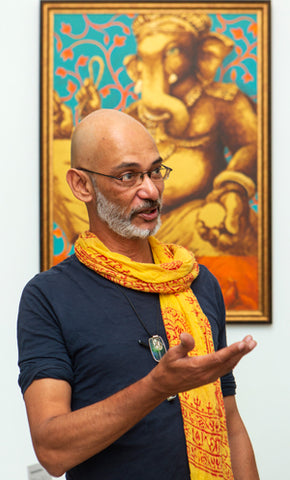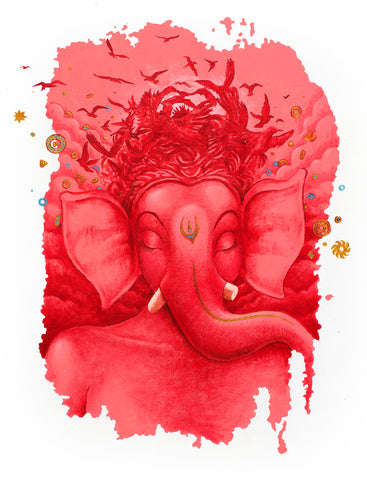Ganeshism as reported in media.
Bonding with Lord Ganesh, By Yomal Senerath-Yapa
(Sunday Times Sri Lanka, 6th January 2019)
Well known for his trademark Ganeshism, artist Mahen Chanmugam is getting ready for the Galle Art Trail.
Talking with Mahen Chanmugam, you occasionally see flashes of the charming enfant terrible he had been – when his face breaks into a roguish smile after a gag, for example. But for the most part Lord Ganesh has converted, and made into an artistic hermit of sorts, the boy who was expelled from S. Thomas’ and Trinity respectively.
A gaunt, charismatic hermit with an aura- wreathed in cigarette smoke and moving with the grace of a yogi in his Nawala home, he is getting ready for the Galle Art Trail, where his art branded Ganeshism, his trademark, will be Number 1 in the trail, housed in the high-ceilinged Dutch colonial splendour of Amangalla Resort. The exhibition will be opened in the evening of January 15 and will go on till the 20th, when the FGLF and the Art Trail end.

Mahen Chanmugam: Looking to Ganesh. Pix by Sameera Weerasekera
Mahen, during the past 28 years, has not deviated from his single-minded focus on portrayals of Ganesh- rarely painting anything else. How did this Anglican- worldly, sophisticated and well-read- find such magnetic allure in Ganapathi?
The precise answer is locked with the mysteries of the cosmos. But Mahen remembers that his first toddler doodlings were always elephants. Growing up, his acts of rebellion at school stemmed from being forced to study conventional subjects while his heart was with an imaginative, creative world.
While working in brand development after quitting school early, he realized that the ‘world’s oldest brands were religions’. The ancient prescriptions of iconography are exact- like the identity guideline systems used for big corporates. And Ganesh, he says, is a very fluid brand as opposed to the more rigid identities of other divine beings. You could be creative with the wise yet jovial, human yet pachyderm deity who had been there from before Hinduism, going back to the Vedic age.
It marked the end of his unbridled living as the image of Ganesh spoke to him more and more. Mahen began by painting the more classical forms, kin to the kovil images. But with time his Ganesh would acquire a thousand maverick forms. All around his house, on canvas, antique doors, windows and boxes, Ganesh poses and cavorts in a hundred guises. There are nude female Ganeshas and a Ganesh in a black and blue jersey flashing peace signs, painted after the Bali bombing. They have a way of swimming into Mahen’s consciousness, though some of them he cannot interpret.
His spiritual metamorphosis can be seen in his paintings across time. While the early Ganeshas have a mystic, intimidating countenance and classic postures, the later Ganeshas seem to have descended from Kailash, with huge doe eyes that curdle with the milk of humane kindness. You feel the palpitating life, love and positive energy they emanate.

For Mahen religion is “the scourge of mankind”, yet his bond with Ganesh- as part of Vedic teaching which is not religion but a way of living- is deep. In the meditative state of painting the god, he has experienced a “strange, euphoric, elated feeling”, which he compares to an out of the body experience.
Mahen’s relationship with Ganesh has gone through many stages. At first he saw a god. Then his interest led him to Vedic studies and he saw Ganesh as a supreme position of the reality. Today Ganesh for him is the ‘root’ or muladhara chakra of Tantrism, the energy at the base of our spine that is also the home of the kundalini power.
For Mahen, his bond with Ganesh would never be that of the supplicant and favour-granting god.
Imbued in all his art is the core of Vedic teaching, where stress is laid on increasing your inner consciousness and awareness. The ultimate goal is being one with god- a metaphor for self realization.
In May last year Mahen closed down their company MCN Creative Associates. Today he explores the philosophical template that the elephant god is to him. His goal, of finding the divinity within himself, is symbolized in one of his most recurrent images: Ganesh, in all his splendour, painted within a gracefully poised yogi or yogini’s silhouette…

Link to the Video of the Galle Art Trail show
---------------------------------------------------------------------------------------------------------
THINK Magazine Singapore, by Adeline Loh, 28 Septembre 2004
As Mahen Chanmugam confesses somewhat self-deprecatingly, "I was anal. I was an overworked, stressed-out creative director."
The solo artist of the sensational Ganeshism art exhibition at Utterly Art now radiates an aura of simplicity; chatting with me on the metamorphosis of the last 8 years, we're seated in Mahen's home, nestled in a obscure part of Singapore (the cab driver certainly got a run for his money), surrounded by his paintings of Lord Ganesh.

"I was quite the party animal," he laughs, "I'm a lot nicer now." It doesn't take a genius to figure out the cause for Mahen's change; religious-themed art has abided through the ages and constantly served as an expression for humanity's spiritual evolution. Everything seems to make perfect sense, till you discover that Mahen isn't a Hindu.
Born in Sri Lanka, he was brought up in a family that converted from Hinduism to Christanity three generations ago and only started to study the iconography and symbolism of Lord Ganesh eight years ago. Without the usual religious undertones, you naturally wonder, what on earth birthed this unusual love for the elephant Hindu God?
"I was fed up with things. I needed to find something that could add meaning in my life. Lord Ganesh just came to me from nowhere," reveals Mahen, "Now, I believe in things happening at the right time because it's supposed to happen because you're looking for it. I started reading up on him as a study and found a lot of things I could relate to."
Incidentally, Lord Ganesh is perceived as one of the most human of the Hindu gods. He's pleasure-loving, enjoys food and drink as shown by his big belly. He symbolizes many things, amongst them creativity, wisdom and success. Ganeshism is a representation of the philosophy Ganesh inspires within Mahen, and he's not the only one.
The old craftsmen who created sculptures of Lord Ganesh had to meditate for months while observing a strict diet, performing a sort of mental gymnastics to create their art simply from the powerful images they conceived in their minds.
You might say Mahen is the modern equivalent of these craftsmen. His work is a startling blend of traditional and modern forms. A first survey of his work has you feeling vaguely reminiscent of the retro era, with luminous pinks, greens and oranges lending a sense of funkiness to the art. Modern touches like the use of lines and circles are also prevalent.
"The modern generation just aren't connecting with traditional, old-style art. I've portrayed Lord Ganesh as bright and funky instead of more dark and moody to make it more touchable for today's young people," explains Mahen," There's a different sort of feeling when you go to a temple. Maybe I might be losing the feeling of reverence a little, but I'm making it more accessible as well."
There's something quite captivating and engaging about reinvention, the transformation of the old into a more contemporary, accessible form. If you would love having one of these paintings printed on the cover of a notebook, then Mahen has just succeeded in bridging the rift between tradition and today's youth. In other words, he's just made something traditional, well, plain cool.
His painting, Lord of Thresholds, proves this point most acutely with its satirical take on Lord Ganesh. Created after the Bali bombing - Mahen was feeling "frustrated with all the violence around" - Ganesh here is dressed in a black and blue jersey, his fingers showing the universal symbol for peace. While Mahen does admits that "purists might find the painting a bit wrong," the picture invokes an almost instantaneous emotional reaction from even the ordinary man.
Besides the emotional responses that Mahen tries to evoke, the paintings stimulate one's mental faculties as well. Each of his paintings have deep philosophical significance. The lotus, for example, symbolises the regeneration of the soul, and in the painting of the same name, the deeper underlying meaning harkens people to see past the mundane and to seek a more truthful and aware approach to life.

With this philosophy firmly in place, Mahen doesn't see himself painting anything else in the future, and is even contemplating quitting his job to paint fulltime. This might not seem such a crazy notion, especially if you start to understand the kind of inner calm his craft has given to him.
To Mahen, "When I paint, it takes me to another plane of consciousness. Ganesh is something on the inside. It's a way of living your life, a way of bringing out the best in me. He teaches you that you have to make the most of your life. You create your own future."
